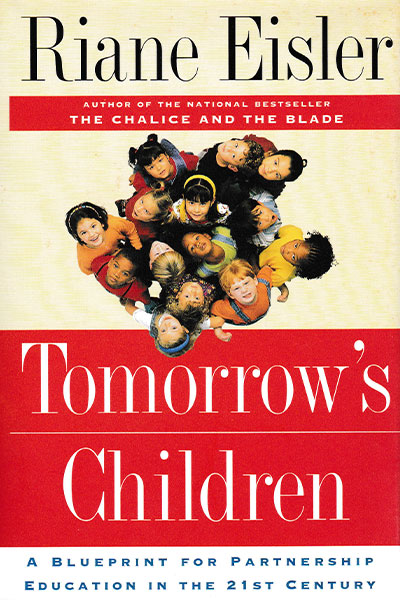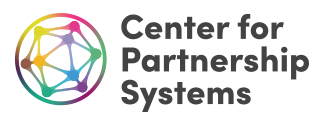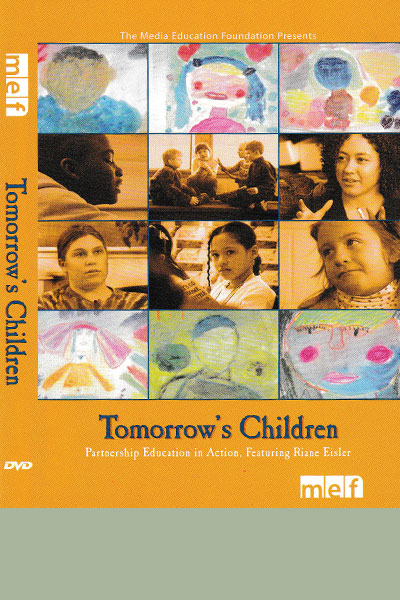
Tomorrow?s Children
In Tomorrow?s Children: A Blueprint for Partnership Education in the 21st Century, Riane Eisler describes three core elements of partnership education: process (how we learn and teach), content (what we learn and teach), and structure (where we learn and teach).
Process, Content, and Structure
Partnership education process is how we teach and learn. Partnership schools and programs integrate new and time-tested approaches that engage children in the joy of lifelong learning.
- Children are seen as partners in the learning process
- Adults model facilitation rather than control
- Every child?s unique abilities are fostered
- Children are treated with empathy and caring
- Diverse learning styles are honored
- Children’s voices are heard and their ideas are respected
- Emotional needs are understood and addressed
- Cooperative learning and individual responsibility are combined
- Learning is a reciprocal activity between teacher and child
- Students learn through experiential opportunities
- Young people think for themselves and trust their observations and experiences
- Students develop and use skills of caring and ethical behaviors
Content
Partnership content is what we teach and learn ? the educational curriculum. Partnership education is not about discarding what many professionals deem important for children to know and do, or about throwing out state standards. What is needed is an integrated framework that combines basic academic content with the information and skills students need for a sustainable, equitable, and peaceful future. Content in partnership education includes standard subjects such as math, reading, writing, science, social studies, art, physical education, music, and computer literacy. Woven into the entire learning tapestry are materials that reflect:
- Gender balance
- Environmental consciousness
- Multiculturalism
- Partnership values and ethical standards
- Partnership literacies and competencies, including emotional literacy, media literacy, systems competence, nonviolent conflict resolution, and responsible leadership
- The partnership-dominator continuum as an analytical lens
- The arts and music
- Partnership language
- Self-regulation and life-planning
- A meaningful story of evolution
- A more accurate and hopeful view of what being human means
Structure
Partnership education structure is about where we teach and learn ? the learning environment. It consists of two parts:
- the architectural or physical structure (the spatial environment)
- the organizational structure (the infrastructure)
Spatial Environment
A partnership spatial environment is inviting and welcomes and celebrates each individual. When visiting a school/program with a partnership spatial environment, one would expect to see:
- Safe spaces with architectural dangers (e.g., dark stairwells) modified or removed
- Full accessibility with architectural barriers removed
- Playgrounds that facilitate cooperation
- Accessible playground equipment
- Welcoming, colorful hallways and wall space that celebrate learning and every person
Infrastructure
The organization of a school or other learning environment models partnership in policy, development, and implementation. It facilitates inclusiveness in decision-making and learning together. One would expect to see:
- Hierarchies of actualization where accountability flows in every direction, rather than hierarchies of control and domination where accountability only flows from the bottom up
- Governance that allows for shared decision-making between administration, staff, and students
- Collaborative planning, collegial dialogue, and continuous learning (such as professional staff development)
- Teachers mentoring each other
- Resource allocations that maximize support for learning
- Inclusion of parents and other community members as volunteers
- Lines
Adapted from Tomorrow’s Children: A Blueprint for Partnership Education in the 21st Century (2000) by Riane Eisler
Resources
Tomorrow?s Children: A Blueprint for Partnership Education in the 21st Century (2000) by Riane Eisler
Tomorrow?s Children: Partnership Education in Action DVD
Sample Resources for College Classes
- Crittenden, A. (2001), The Price of Motherhood: Why the Most Important Job in the World Is Still the Least Valued, New York: Metropolitan Books.
- de Leon, E. and Boris, E.T. (2010), The State of Society: Measuring Economic Success and Human Well-Being, Washington, DC: The Urban Institute.
- de Leon, E. (2012), National Indicators and Social Wealth, Washington, DC: The Urban Institute.
- Eisler, R. (1987). The Chalice and the Blade: Our History, Our Future. San Francisco: Harper and Row.
- ————. (1995). Sacred Pleasure: Sex, Myth, and the Politics of the Body. San Francisco: Harper Collins.
- ————. (2000). Tomorrow?s Children: A Blueprint for Partnership Education in the 21st Century. Boulder, Colorado: Westview Press
- ————. (2002). The Power of Partnership: Seven Relationships that Will Change Your Life. Novato, California: New World Library.
- ————. (2007). The Real Wealth of Nations: Creating a Caring Economics. San Francisco: Berrett-Koehler.
- Eisler, R. Loye, D. and Norgaard, K. (1995), Women, Men, and the Global Quality of Life, Pacific Grove: California: Center for Partnership Studies.
- Erz, L,F. (1998) ?The Challenge of Language: Teaching the Language of Partnership.? Riane Eisler, R. and Loye, D.eds. The Partnership Way: New Tools for Living and Learning, 2nd edition. Pacific Grove, California: Center for Partnership Studies.
- Folbre, N. (2001), The Invisible Heart: Economics and Family Values, New York: New Press.
- Gimbutas, M. (1982). The Goddesses and Gods of Old Europe. Berkeley: University of California Press.
- Hausmann, R., Tyson,, L.D., and Zahidi, S.S. (2011) The Global Gender Gap Report. The World Economic Forum
- Hodder, I. (2004. Women and men at Catalhoyuk. Scientific American (January): 77?83.
- Inglehart, R., Norris, P., and Welzel, C. (2002), ?Gender equality and democracy,? Comparative Sociology Vol. 1, No 3-4, pp. 321-346.
- Jain, D. and Banerjee, N. (1985), The Tyranny of the Household: Women and Poverty. New Delhi: Shakti Books.
- Kramer, S. N. (1963), The Sumerians. Chicago: University of Chicago Press.
- Marinatos, N. (1993). Minoan Religion: Ritual, Image, and Symbol. Columbia: University of South Carolina Press.
- Mellaart, J. (1967) ?atal H?y?k. New York: McGraw-Hill.
- Min, J. ed. (1995. The Chalice and the Blade in Chinese Culture: Gender Relations and Social Models. Beijing: China Social Sciences Publishing House.
- Niehoff, D. (1999), The Biology of Violence: How Understanding the Brain, Behavior, and Environment Can Break the Vicious Circle of Aggression. New York: Free Press.
- Noddings, N. (2002), Starting at Home: Caring and Social Policy. Berkeley: University of California Press.
- Ornstein, R.(1972). The Psychology of Consciousness. New York: Viking.
- Perry, B. (2002), ?Childhood experience and the expression of genetic potential: what childhood neglect tells us about nature and nurture,? Brain and Mind., Vol. 3, No.1, pp.79-100.
- Sanday, P. R. Women at the Center. Ithaca, N.Y.: Cornell University Press, 2002.
- Schwab, K. (ed.) (2010), The Global Competitiveness Report 2010-2011, Geneva, Switzerland: World Economic Forum.
- Schlegel, S. Wisdom from a Rainforest. Athens: University of Georgia Press, 1998.


